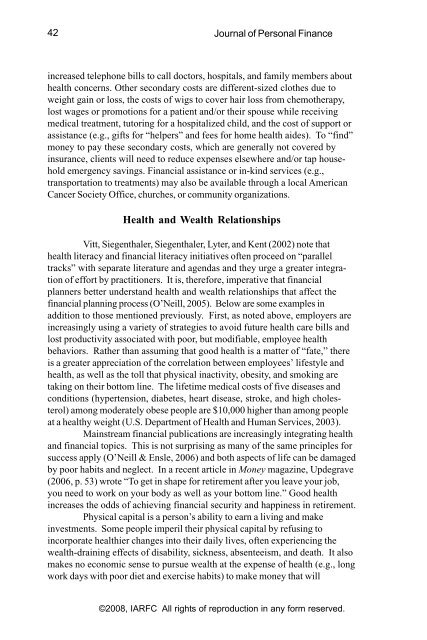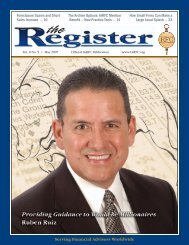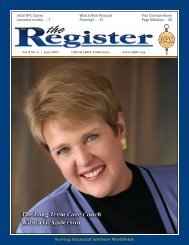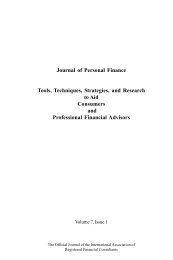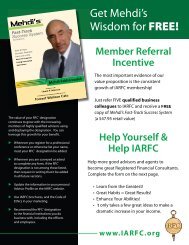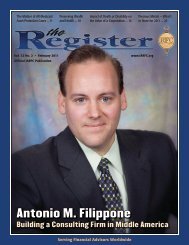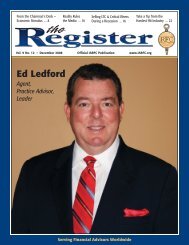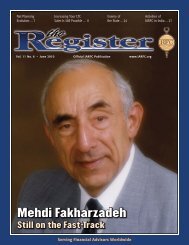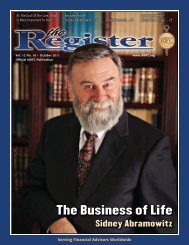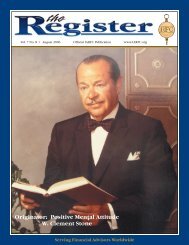3433-vol. 6 issue 2-3.pmd - iarfc
3433-vol. 6 issue 2-3.pmd - iarfc
3433-vol. 6 issue 2-3.pmd - iarfc
You also want an ePaper? Increase the reach of your titles
YUMPU automatically turns print PDFs into web optimized ePapers that Google loves.
42<br />
Journal of Personal Finance<br />
increased telephone bills to call doctors, hospitals, and family members about<br />
health concerns. Other secondary costs are different-sized clothes due to<br />
weight gain or loss, the costs of wigs to cover hair loss from chemotherapy,<br />
lost wages or promotions for a patient and/or their spouse while receiving<br />
medical treatment, tutoring for a hospitalized child, and the cost of support or<br />
assistance (e.g., gifts for “helpers” and fees for home health aides). To “find”<br />
money to pay these secondary costs, which are generally not covered by<br />
insurance, clients will need to reduce expenses elsewhere and/or tap household<br />
emergency savings. Financial assistance or in-kind services (e.g.,<br />
transportation to treatments) may also be available through a local American<br />
Cancer Society Office, churches, or community organizations.<br />
Health and Wealth Relationships<br />
Vitt, Siegenthaler, Siegenthaler, Lyter, and Kent (2002) note that<br />
health literacy and financial literacy initiatives often proceed on “parallel<br />
tracks” with separate literature and agendas and they urge a greater integration<br />
of effort by practitioners. It is, therefore, imperative that financial<br />
planners better understand health and wealth relationships that affect the<br />
financial planning process (O’Neill, 2005). Below are some examples in<br />
addition to those mentioned previously. First, as noted above, employers are<br />
increasingly using a variety of strategies to avoid future health care bills and<br />
lost productivity associated with poor, but modifiable, employee health<br />
behaviors. Rather than assuming that good health is a matter of “fate,” there<br />
is a greater appreciation of the correlation between employees’ lifestyle and<br />
health, as well as the toll that physical inactivity, obesity, and smoking are<br />
taking on their bottom line. The lifetime medical costs of five diseases and<br />
conditions (hypertension, diabetes, heart disease, stroke, and high cholesterol)<br />
among moderately obese people are $10,000 higher than among people<br />
at a healthy weight (U.S. Department of Health and Human Services, 2003).<br />
Mainstream financial publications are increasingly integrating health<br />
and financial topics. This is not surprising as many of the same principles for<br />
success apply (O’Neill & Ensle, 2006) and both aspects of life can be damaged<br />
by poor habits and neglect. In a recent article in Money magazine, Updegrave<br />
(2006, p. 53) wrote “To get in shape for retirement after you leave your job,<br />
you need to work on your body as well as your bottom line.” Good health<br />
increases the odds of achieving financial security and happiness in retirement.<br />
Physical capital is a person’s ability to earn a living and make<br />
investments. Some people imperil their physical capital by refusing to<br />
incorporate healthier changes into their daily lives, often experiencing the<br />
wealth-draining effects of disability, sickness, absenteeism, and death. It also<br />
makes no economic sense to pursue wealth at the expense of health (e.g., long<br />
work days with poor diet and exercise habits) to make money that will<br />
©2008, IARFC All rights of reproduction in any form reserved.


